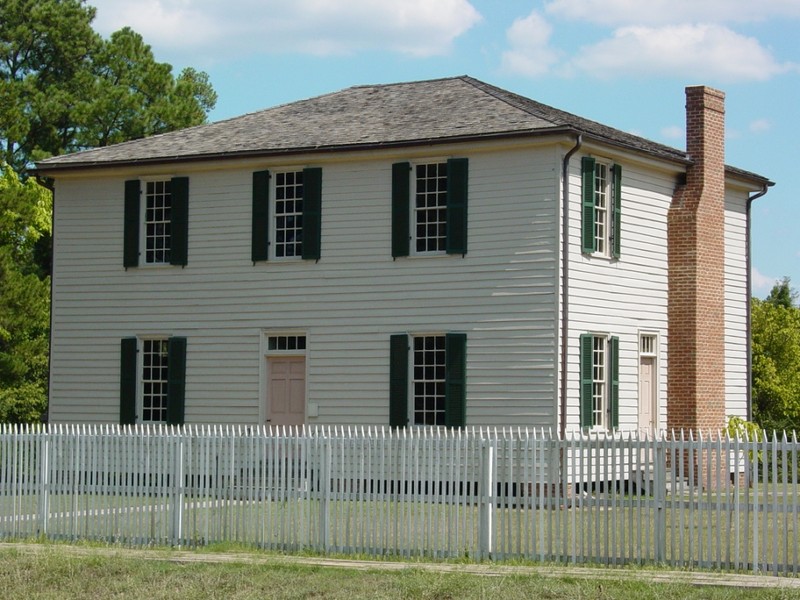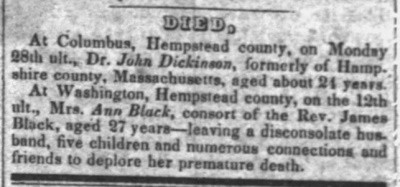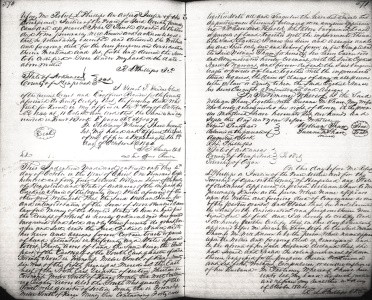The Tragedy Of James Black
Introduction
Text-to-speech Audio
James Black had been successful serving in different posts for the county as deputy jailor, road overseer, juror, and was elected in 1834 as 1 of 5 trustees for the community of Washington. Not long after the birth of his fifth child, Black’s life began a series of hardships starting with the death of his wife, Anne, on September 12, 1835. Many of the events that followed in his life took place at the 1836 Hempstead County Courthouse. Guided tours are available of the building. Visit the Historic Washington State Park Visitor Center for more information.
Images
1836 Hempstead County Courthouse, where court business regarding James Black occured

Obituary of Anne Black in the Arkansas Gazette on October 6, 1835

Deed registered with Hempstead County of the sale of William Shaw's property in 1844

Backstory and Context
Text-to-speech Audio
Black married Anne Shaw, the daughter of his first business partner, against her father's wishes. William Shaw saw his now-rival Blacksmith become more successful and popular as the legend of the Bowie Knife spread.
In 1836, a new county courthouse building was completed in Washington on the city block that was allotted as the Public Square for county use. The courthouse was a two story structure built in the Federalist style of architecture. It was on this site, that William Shaw went to the circuit court and was declared the guardian of James Black in 1836. According to Shaw, Black had times of insanity and could not take care of his personal affairs.
Later James Black became seriously ill . According to Black, Shaw went to Black's house and beat him so severely that he was nearly blinded. Black left Washington looking for a procedure that could restore his sight, traveling as far as Ohio. In 1840, in this building, the court gave Shaw the right to auction James Black’s estate. On October 25, 1841, James Black’s children were made apprentices to their grandfather William Shaw. Three years later, Shaw sold his property and took the children with him to Texas. James Black never saw his children again.
Black was left behind with no money, no family, almost no sight, and was starting to show signs of dementia. In 1844, the Hempstead County Court declared Black a pauper of the county and placed him under the care of Dr. Isaac Newton Jones.
Sources
Batson, Jr., James L.. James Black and his Coffin Bowie Knives. Huntsville, Alabama. Batson Engineering and Metalworks, 2019.
"The Bowie Knife." Washington Telegraph (Washington) December 8th 1841. , p. 2.
Brooke, Steven. Historic Washington, Arkansas. Gretna, Louisiana. Pelican Publishing Company, 2000.
Medearis, Mary. Washington, Arkansas : History on the Southwest Trail. Hope, Arkansas. Copies + Office Solutions, 1984.
Williams, Charlean Moss. The Old Town Speaks : Washington, Hempstead County, Arkansas, gateway to Texas, 1835, Confederate capital, 1863. Houston, Texas. The Anson Jones Press, 1951.
Williams, Joshua. Washington. Images of America. Charleston, South Carolina. Arcadia Publishing, 2014.
Williams, Joshua. Black, James, Encyclopedia of Arkansas . November 18th 2011. Accessed April 15th 2022. https://encyclopediaofarkansas.net/entries/james-Black-2534/.
Historic Washington State Park
Southwest Arkansas Regional Archives
Southwest Arkansas Regional Archives
